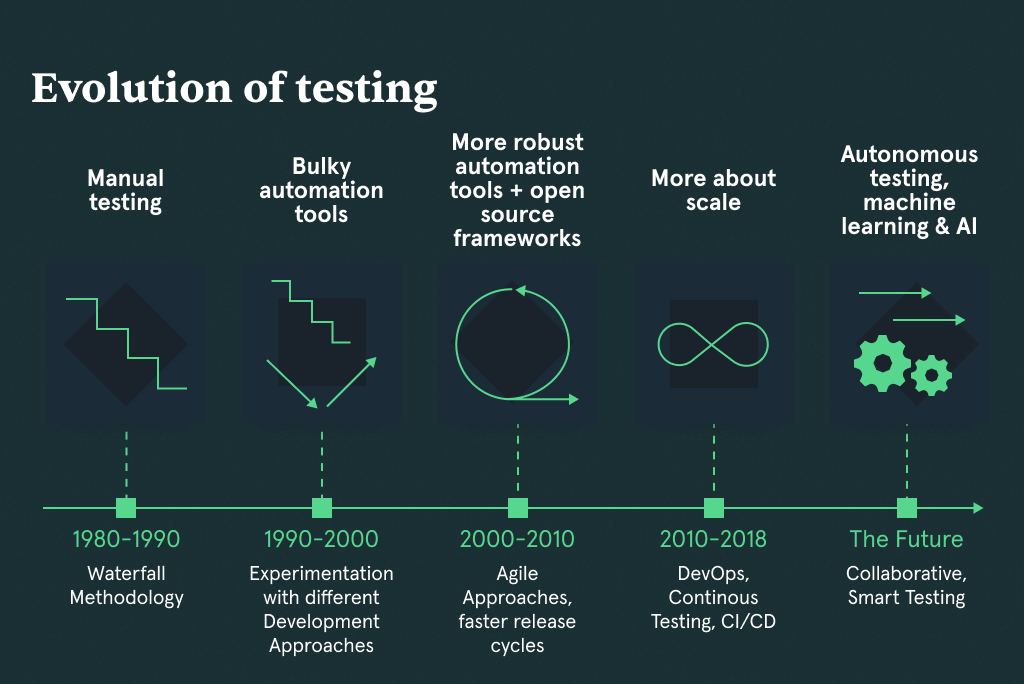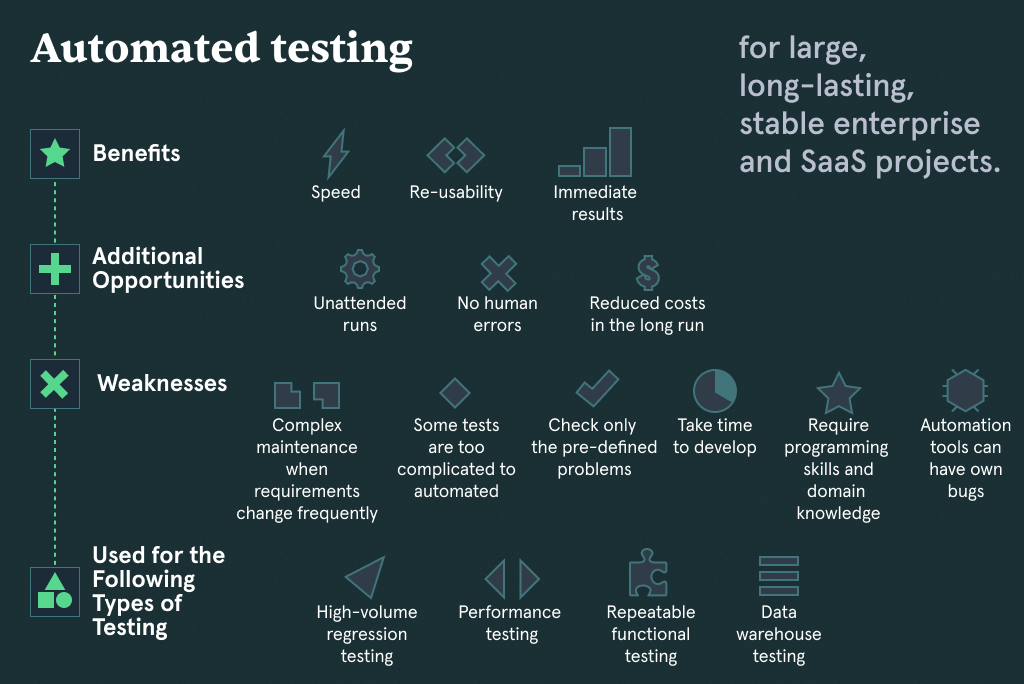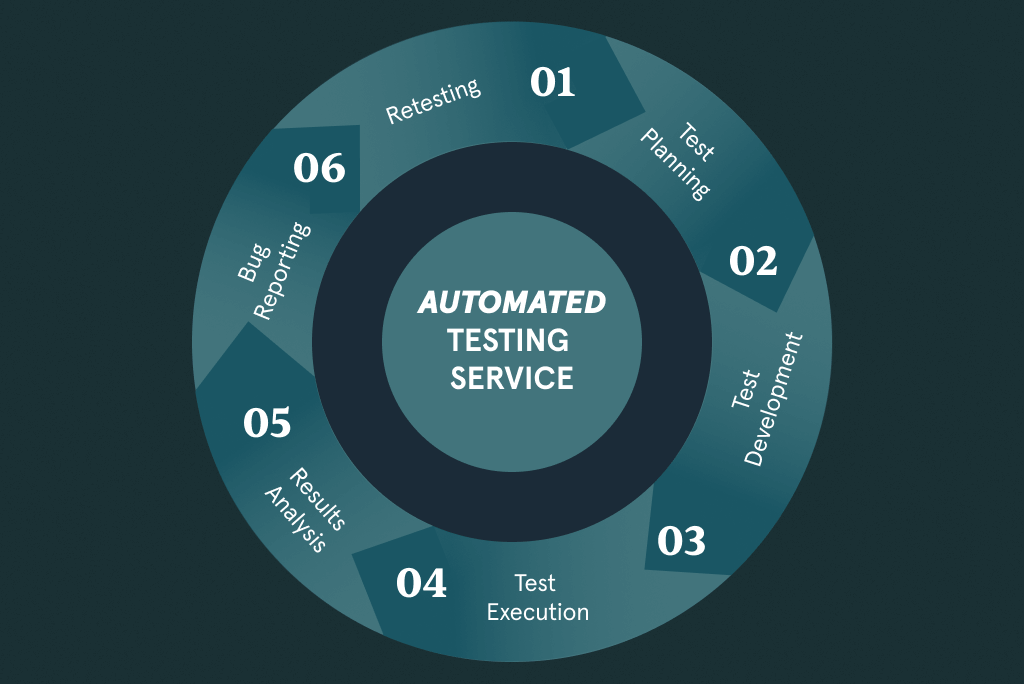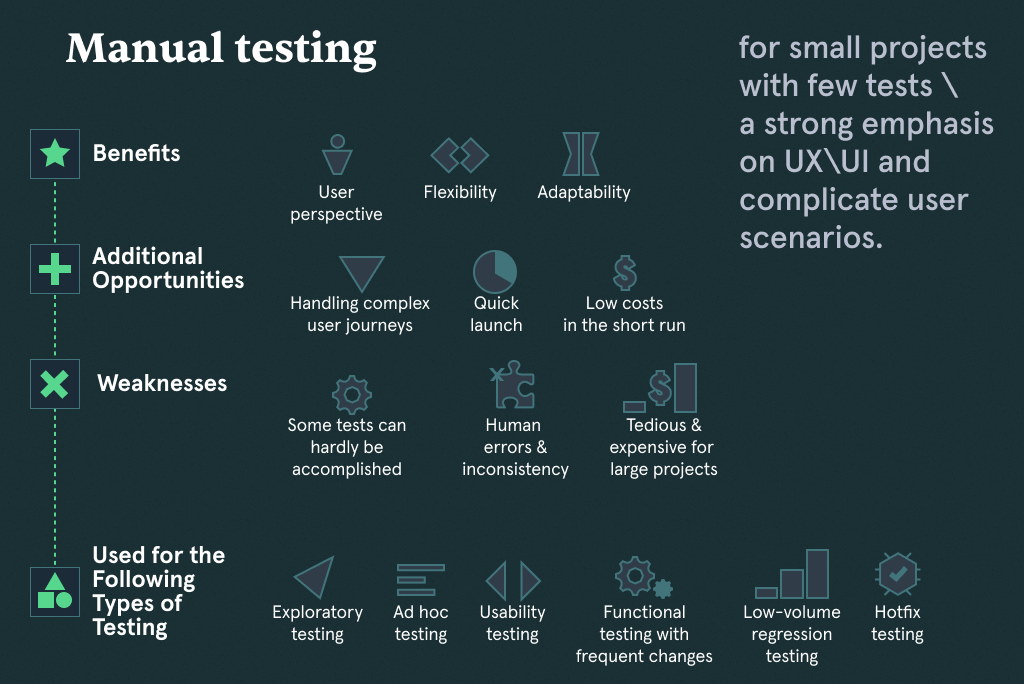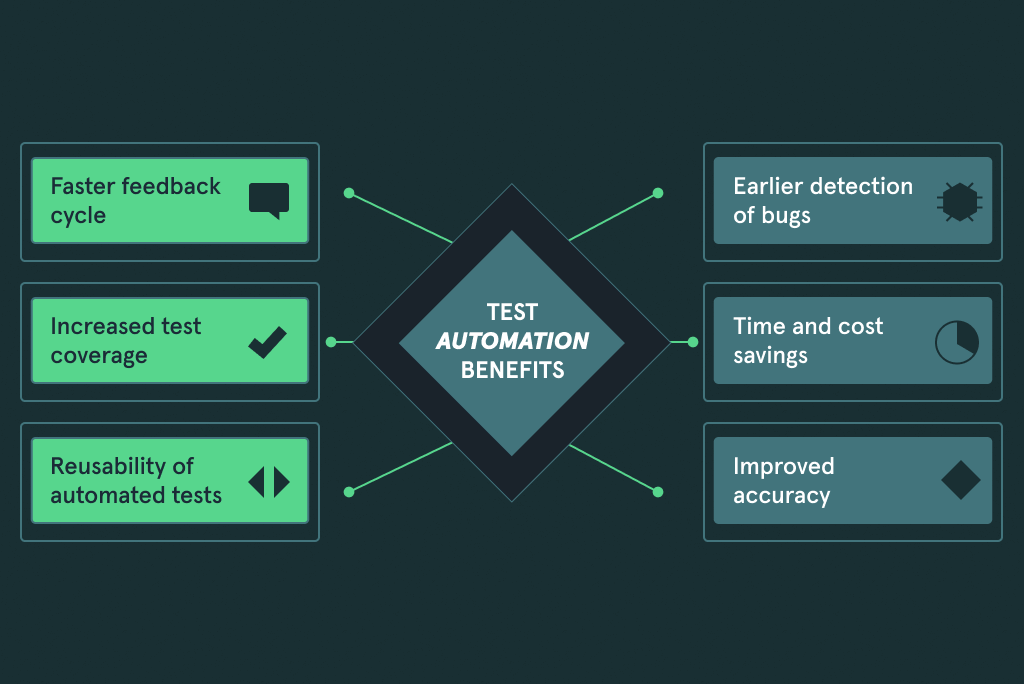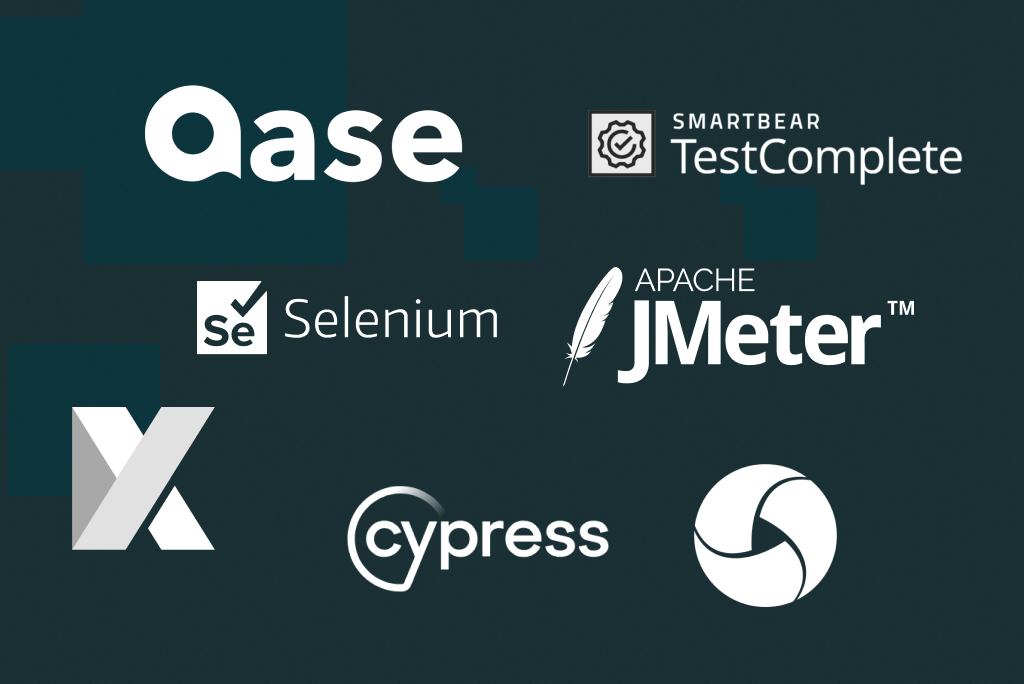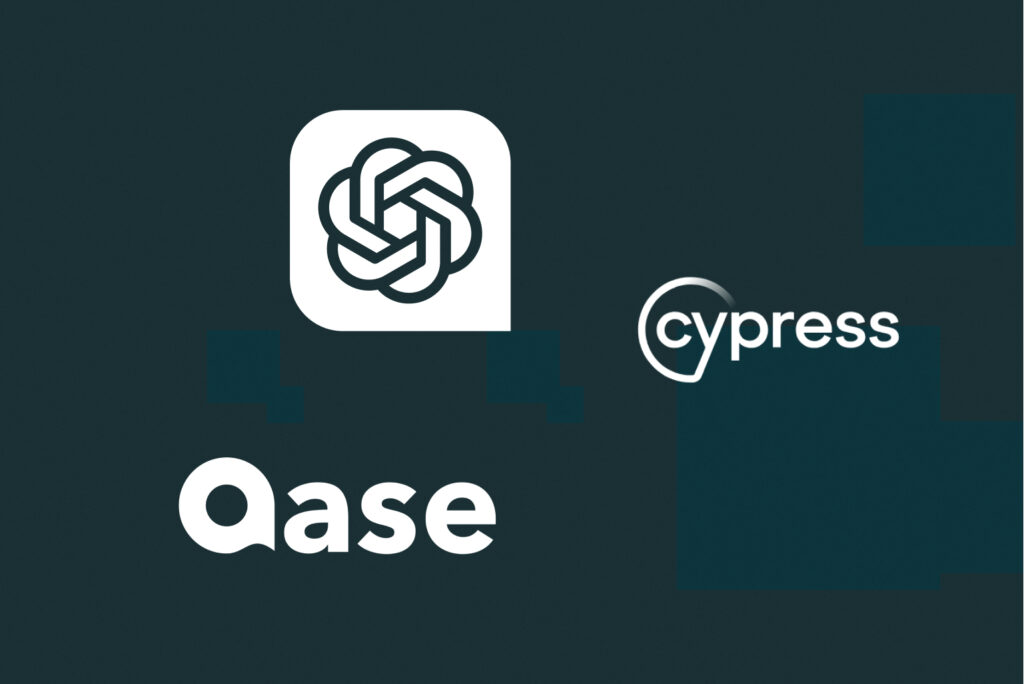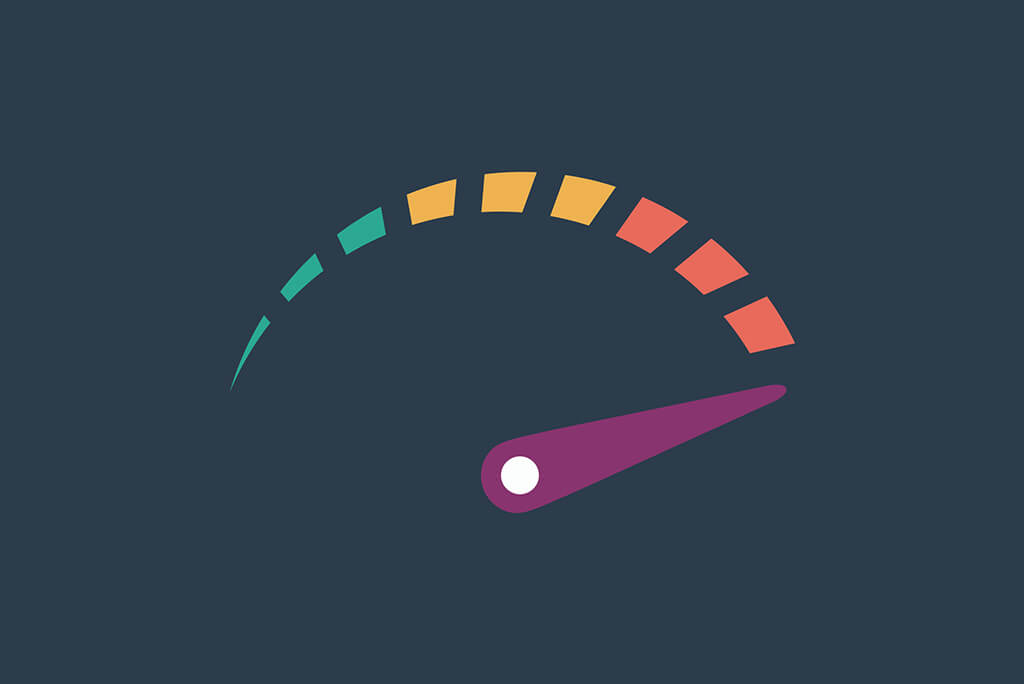In the era dominated by digital transformation, businesses need to be agile, resilient, and responsive. A crucial cog in this mechanism is the quality of digital solutions, as they are the bedrock upon which businesses build their services.
Quality Assurance (QA) is indispensable in ensuring these solutions work flawlessly. But with growing complexity and scale, manual QA testing has started to feel like trying to catch a waterfall with a teacup. It’s a battle against time, and often, bugs sneak through. Enter the superhero of our story – automated QA testing.
But what is automated QA testing? Why is it vital for businesses today, and how can it impact the quality of your digital systems
This comprehensive guide is designed to answer all these questions and more. Whether you’re a tech enthusiast wanting to learn about the latest trends or a business professional looking to leverage technology for better efficiency, this guide provides invaluable insights into automated QA testing.
We’ll explore the evolution of automated QA testing, demystify its processes, dive into some of the most popular QA automation tools in the market, and look at its role in continuous delivery. We’ll also share how we ace automated QA testing with Artificial Intelligence and bust some common myths around it.
So, buckle up, and let’s go through automated QA testing!
The Evolution of Automated QA Testing
Embarking on our journey into the world of automated QA testing, it’s important to start at the beginning. Like all great tales, our story begins with a simpler time – a time before the complexities of multi-threaded applications, a deluge of data, and the need for instantaneous results.
In the earliest days of computing, QA was a manual process. Software testers would spend countless hours manually inputting data, executing tests, and recording results. It was laborious, time-consuming, and, frankly, quite prone to human errors. It was like being on a never-ending treadmill, running relentlessly but not going anywhere fast.
The first major shift came with the advent of ‘record and playback’ tools in the late 1980s. These tools could record a series of user actions and then replay them, allowing repeated testing of user interactions. It was like having a parrot in your testing team, imitating the end user behavior over and over again. However, these tools had their limitations – they lacked flexibility and often failed when confronted with even the slightest changes in the application.
As digital solutions grew in complexity, the demand for more sophisticated testing tools became more pressing. The 1990s saw the rise of data-driven testing frameworks. These allowed testers to separate the test script logic from the test data, making it easier to perform the same tests with different data sets. Imagine being a chef who could whip up multiple dishes using the same recipe, just by changing the ingredients!
The early 2000s marked another milestone in the QA journey with the advent of behavior-driven and test-driven development methodologies. These promoted a more collaborative approach, involving both developers and stakeholders in the testing process.
Today, the landscape of automated QA testing is more dynamic than ever. With artificial intelligence (AI) and machine learning (ML) stepping into the scene, automation has taken on a new dimension. We now have tools that can generate and optimize tests on their own, predict potential problem areas, and even understand the visual elements of an application!
From the laborious manual testing processes of the past to the swift, AI-powered solutions of today, automated QA testing has come a long way. And as we delve deeper into this journey, it’s clear that automated QA testing is more than just a technological development – it’s a testament to human ingenuity and our constant pursuit of efficiency and excellence.
So, as we stand at the frontier of this exciting evolution, one can only wonder – what’s next? Stick around as we explore this and much more in the chapters to come.
Understanding Automated QA Testing
As we further explore automated QA testing, it’s vital to grasp what it entails fully. It comes equipped with various tools and techniques, each designed to ensure your solution’s functionality, performance, and overall quality. But let’s break it down a bit further.
What is Automated QA Testing?
In the simplest terms, automated QA testing involves using specialized tools to control the execution of tests and comparing the actual outcomes with predicted outcomes. It’s like having a diligent detective who inspects every nook and cranny of your software, ensuring everything is in its place and functioning as expected. Automating repetitive tasks frees up your QA team’s time, allowing them to focus on more complex tasks requiring human ingenuity.
The QA Testing Process: An Overview
The Automated QA testing process typically involves the following steps:
- Test Planning: This initial stage involves identifying what parts of the solution will be tested, defining the testing strategy, and preparing the test environment.
- Test Development: Here, test cases are developed based on the software requirements, and automated scripts are written to perform these tests.
- Test Execution: The automated scripts run the tests on the software, either as part of the development process or after a new solution version is ready for testing.
- Result Analysis: The results of the tests are analyzed to identify any deviations from the expected behavior.
- Bug Reporting: Any defects discovered are reported to the development team for fixing.
- Retesting: After debugging, the tests are rerun to ensure the fixes have worked and haven’t introduced new bugs.
Why Automation in QA Testing?
Imagine you’re building a sandcastle. Checking every grain of sand manually would be a painstaking and time-consuming task, right? That’s where automation comes in. Automated QA testing can handle repetitive tasks efficiently, ensuring nothing slips through the cracks. It boosts efficiency, enhances accuracy, speeds up the testing process, and significantly reduces the risk of human error.
From verifying new features to regression testing and load testing, automated QA testing covers a wide range of testing needs, making it an indispensable tool in today’s fast-paced software development world. Whether you’re launching a groundbreaking app or updating your website, QA automated testing ensures that your users get the best possible experience.
Key Differences Between Manual and Automated QA Testing
The primary distinction between manual and automated testing lies in their execution. Manual testing requires human effort for each test, making it time-consuming, especially for large-scale projects. Conversely, automated testing can perform the same tasks swiftly, making it efficient for repetitive tasks and regression testing.
Yet, the role of manual testing can’t be entirely negated. It’s invaluable for exploratory testing, usability testing, and when the project is in its initial stages and the requirements are continually changing.
When to Use Manual Testing and When to Use Automated Testing
The choice between manual and automated testing depends on various factors including project requirements, budget, timeline, expertise, and suitability. Manual testing is suitable for exploratory, usability, and ad-hoc testing, while automated testing is ideal for regression, load, and repeated execution testing.
So there you have it – the ABCs of automation in QA testing. As we move forward, we will venture into the land of QA automation tools, explore the role of automated QA testing in continuous delivery, and much more. Fasten your seatbelts as we dive deeper into this intriguing journey.
The Benefits of QA Testing Automation
Now that we have a deeper understanding of automated QA testing, it’s time to illuminate the myriad benefits this technique brings to the software development landscape. These benefits have been recognized across various industries, reinforcing the notion that automated QA testing is an invaluable asset in any development strategy.
Faster Feedback Cycle
Automated QA Testing drastically reduces the time required to run repetitive tests, allowing teams to receive faster feedback on their work. It’s like having a superfast correspondent who reports back from the front lines in a blink of an eye. This rapid feedback enables teams to catch and address issues early in the development cycle, making it easier (and cheaper) to fix them.
Increased Test Coverage
Automated testing tools can easily execute thousands of complex test cases during every test run providing coverage that is impossible with manual tests. It’s akin to having a legion of diligent inspectors examining your software under a magnifying glass, ensuring no stone is left unturned. Increased test coverage leads to testing more features and improving the digital solution’s quality.
Reusability of Automated Tests
Automated test cases can be reused for different solution versions, making it a cost-effective and time-saving method. Imagine having a master blueprint that can be applied across numerous projects, significantly reducing the groundwork each time.
Earlier Detection of Bugs
Since the automated testing process begins early in the software development lifecycle, it aids in the early detection and fixing of defects. Catching bugs early is like plucking weeds from your garden as soon as they sprout, preventing them from proliferating and causing further damage.
Time and Cost Savings
Automated QA Testing speeds up the testing process and minimizes the need for manual intervention, leading to substantial time and cost savings. It’s like having a turbocharged engine in your car that allows you to reach your destination in record time and at a fraction of the cost.
Improved Accuracy
Even the most conscientious tester can make mistakes during monotonous manual testing. Automated QA testing eliminates the chances of human error, providing highly accurate results. It’s like having a meticulous robot performing the checks with unmatched precision.
While this is not an exhaustive list, it certainly illustrates why automated QA testing is considered a critical component in modern software development. As we move forward in our exploration, we’ll confront and debunk common myths surrounding automated QA testing, helping us separate fact from fiction. So stay tuned!
Optimization Sell more effectively with a fast Magento website and blow your competition out of the water.

Tools of the Trade: Exploring Popular QA Automation Tools
Now that we have a solid understanding of automated QA testing, let’s take a closer look at the tools that make this process possible. Much like a skilled carpenter with a well-stocked toolbox, a good QA tester needs a variety of tools to ensure your products are as bug-free as possible.
Introduction to Popular QA Automation Tools in the Market
- Selenium: Often considered the ‘gold standard’ of automated testing, Selenium is an open-source tool that supports a wide range of programming languages, platforms, and browsers. It’s like the multi-lingual whiz kid who fits in anywhere.
- TestComplete: A comprehensive automation tool from SmartBear, TestComplete supports both desktop and mobile applications. It’s known for its user-friendly interface, making it a hit among testers who may not be hardcore programmers.
- Katalon Studio: A complete automation platform for continuous testing, Katalon Studio supports web, API, mobile, and desktop applications. Think of it as the Jack-of-all-trades in your testing toolkit.
- JMeter: If load testing is your focus, Apache JMeter might just be your new best friend. This open-source tool is designed to load test functional behavior and measure performance, ideal for when you need to simulate a stampede of users on your app or website.
- Appium: For mobile app testers, Appium provides an open-source solution that supports both Android and iOS platforms. It’s like a universal remote, controlling any device it’s paired with.
- Cypress: This is an end-to-end testing framework designed to handle anything that runs in a browser. Its ease of setup, coupled with real-time reloading, automatic waiting, and consistent results, makes it a favorite among developers looking to test more efficiently.
- Qase.io: If you’re looking for a comprehensive and user-friendly test management solution, Qase.iO stands out for its intuitive interface and powerful features designed to simplify and streamline testing processes.
Each of these tools has unique features tailored to specific testing needs. Selenium, for instance, is prized for its flexibility and compatibility, allowing testers to write scripts in several programming languages and run tests across various browsers.
On the other hand, TestComplete offers a record-and-playback feature, allowing testers to create scripts without writing a single line of code. And then there’s Katalon Studio, with its dual scripting interfaces for beginners and experts, making it a versatile choice for teams of all skill levels.
How to Choose the Right Automated QA Testing Tool: A Guide for Success
Let’s equip you with some practical tips on choosing the right automated testing tool. This decision can significantly impact the effectiveness of your testing process, so it’s important to make an informed choice.
- Identify your requirements
First things first, you need to clearly define your testing requirements. What are you aiming to test – web applications, mobile apps, APIs? Which languages does your application use? Understanding your needs can significantly narrow down the pool of suitable tools.
- Evaluate the tool’s capabilities
Once you have a shortlist, evaluate each tool based on its capabilities. Does it support the type of testing you need – functional, performance, security? How well does it integrate with your existing development tools? Consider conducting a trial run to assess the tool in action.
- Consider the learning curve
Every tool comes with its learning curve. Evaluate how user-friendly the tool is and what kind of training or support the vendor provides. Tools that are easy to learn and use can significantly speed up your testing process.
- Look at the costs
Budget is a crucial factor in any decision-making process. Look beyond the initial purchase cost – consider the costs of training, maintenance, and upgrades. Sometimes, a tool with a higher upfront cost may end up being more cost-effective in the long run.
- Check the tool’s scalability
As your business grows, your testing needs will evolve. Choose a tool that can scale with your needs, supporting larger test suites and more complex scenarios.
- Community and support
A vibrant community and robust support from the vendor can be a lifeline when you encounter issues. Check if the tool has an active forum, regular updates, and responsive customer support.
Choosing the right Automated QA Testing tool is a critical step towards harnessing the power of automation. We hope these tips help you make an informed choice and propel you towards testing success.
Lean about the state of headless in eCommerce

The Role of Automated QA Testing in Continuous Delivery
If you’ve ever been on a well-coordinated relay race team, you understand the beauty of a seamless handoff. In the realm of software and web development, Continuous Delivery (CD) is that meticulously coordinated team, and automated QA testing is the dependable runner, ensuring a smooth transition from development to deployment.
Understanding Continuous Delivery
In essence, Continuous Delivery is a development strategy that emphasizes short, frequent changes to code, which are automatically tested and prepared for release to production. It’s like having a production line that churns out ready-to-deploy software updates at a rapid pace.
How Automated QA Testing Contributes to CD
Automated QA Testing plays an integral role in the CD process, serving as the vigilant gatekeeper that ensures each change is ready for deployment. By automating repetitive testing tasks, it frees up time for teams to focus on building new features and improving existing ones.
But the benefits don’t stop there. Automated QA testing provides quick feedback on code changes, helps uncover issues early in the development process, and reduces the risk of bugs making it to production. It’s like having an ever-alert watchdog, keeping an eye on software quality while the team focuses on continuous improvement.
The Benefits and Challenges of Integrating Automated QA Testing into a CD Environment
Integrating Automated QA Testing into a CD environment comes with several benefits. It accelerates the testing process, increases the frequency of releases, and enhances software quality, leading to a better user experience. In essence, it’s like turbocharging your solutions delivery pipeline.
However, the integration is not without challenges. It requires a shift in mindset towards a culture of continuous improvement, significant investment in testing infrastructure, and a commitment to maintaining test scripts as the software evolves. Think of it as nurturing a garden – it needs consistent attention, care, and a bit of hard work, but the resulting blooms make it all worthwhile.
Debunking Myths: Setting the Record Straight on Automated QA Testing
While the adoption of automation of quality assurance testing has been growing, there are still misconceptions that may deter some from fully embracing this invaluable tool. Fear not! We’re here to set the record straight and debunk some of these common myths.
Myth #1: Automated QA Testing Is Going to Replace Manual Testing
The Reality: While it’s true that automation can speed up the testing process and increase efficiency, it doesn’t mean that manual testing is obsolete. Think of it as a superhero team-up rather than a rivalry. Automated and manual testing complement each other, each with its strengths and use-cases. For example, automated testing is excellent for repetitive tasks and heavy load testing, while manual testing is great for exploratory testing and testing that requires human intuition and judgment.
Myth #2: Automated QA Testing Is Too Expensive
The Reality: The initial setup for automated testing can indeed require a significant investment. However, it’s crucial to consider the long-term ROI. Automated tests can be run countless times at no additional cost, they increase test coverage, improve accuracy, and significantly reduce the time required for testing, leading to substantial savings over time. It’s like investing in a high-quality piece of machinery that will save money in the long run.
Myth #3: Every Test Should Be Automated
The Reality: While automated testing offers many benefits, not every test should or can be automated. Test automation requires time and effort, so it’s crucial to prioritize based on factors like the complexity of the test, frequency of use, and the possibility of human error. For example, tests that need to be executed frequently or those that are prone to human error are good candidates for automation.
Myth #4: Automated QA Testing Is Only for Tech Giants
The Reality: Automated QA testing is for everyone! While large tech companies may have been early adopters, automated testing tools have become increasingly accessible to businesses of all sizes. Whether you’re a start-up launching your first app or a medium-sized business expanding your digital services, automated testing can help you deliver high-quality software to your users.
By debunking these myths, we hope to clear any misconceptions and present a more accurate picture of Automated QA Testing. Up next, we’ll put on our futuristic glasses and gaze into what lies ahead for automation in quality assurance testing. So, don’t change that channel!
The Future of Automated QA Testing: A Glimpse into What Lies Ahead
As we near the end of our journey, it’s time to take a leap of faith and venture into the future of Automated QA Testing. Buckle up, as we make our predictions based on current trends and advancements in the field.
Rise of AI and Machine Learning in Testing
Artificial Intelligence (AI) and Machine Learning (ML) are not just buzzwords anymore; they’re transforming how we approach Automated QA Testing. They can help create more intelligent, adaptive testing strategies and predict potential problem areas based on historical data. Imagine having a crystal ball that not only conducts tests but also anticipates where issues might occur.
Increased Integration with DevOps and Agile
As more organizations embrace DevOps and Agile methodologies, Automated QA Testing will become even more integral to these workflows. It’s like a cog in the software development machine, enabling rapid, continuous delivery of high-quality software.
Shift Towards Performance and Security Testing
With users demanding faster, more secure applications, we predict a greater focus on automated performance and security testing. Tools capable of simulating high loads or identifying potential security vulnerabilities will be worth their weight in gold. It’s like having a virtual fortress that ensures your software can withstand heavy traffic and fend off cyber attacks.
More User-Friendly Automation Tools
As the demand for Automated QA Testing grows, so will the range of tools available. We anticipate a rise in more user-friendly automation tools that require less technical expertise, making automation more accessible to a broader range of professionals. It’s like having a toolkit that anyone, even those without a programming background, can effectively use.
As we look ahead, the future of Automated QA Testing seems promising, filled with technological advancements that will continue to enhance the speed, accuracy, and efficiency of testing. Whether you’re just dipping your toes into the world of automation or are already an experienced tester, there’s a lot to look forward to.
Case Study by GoMage: Pioneering the Future with AI-Driven Automated QA Testing for Adobe Commerce
Following our exploration of how AI can significantly enhance automated QA testing, let’s delve into a practical implementation that marries these cutting-edge technologies to supercharge testing for Adobe Commerce.
Our team created a unique functionality designed for the automatic generation of automated tests using Cypress. The process leverages the API of Qase.io, a powerful test management platform, for step descriptions. But, what makes this approach particularly innovative is the role of ChatGPT: the code generation for these Cypress automated tests is handled entirely by this advanced AI model.
In this setup, each component plays a crucial role:
- Cypress: A front-runner in end-to-end testing, Cypress forms the backbone of the automated testing process, enabling thorough and efficient testing within the browser environment.
- Qase.io: Acting as the guide, Qase.io provides the roadmap for the tests via step descriptions. These descriptions act as a blueprint, outlining what each test needs to accomplish.
- ChatGPT: The magic ingredient in this process, ChatGPT translates the step descriptions from Qase.io into executable Cypress code. It’s like having an expert coder at your disposal, turning plans into action.
This fusion of Cypress, Qase.io, and ChatGPT opens a new frontier in automated QA testing for Adobe Commerce. It showcases how AI can complement and enhance traditional testing tools to generate tests automatically, reducing manual effort, and increasing efficiency. As we spend less time on projects testing while delivering higher testing quality, our clients are charged with less billable hours.
It’s an exciting glimpse into the future of automated QA testing, where AI and automation go hand-in-hand to raise the bar for digital solutions quality. And it’s just the beginning of this exhilarating journey!
Conclusion: Embracing the Future with Automated QA Testing
As we reach the end of our journey through the realm of Automated QA Testing, we hope you now feel well-equipped to navigate this exciting landscape.
The value of automated QA testing is undeniable – from faster feedback cycles to increased test coverage, cost savings, improved accuracy, and more. As the pace of technological innovation accelerates, QA automation will continue to play a pivotal role in delivering high-quality software at speed.
Remember, though, that automation is not a magic wand that can solve all testing challenges. It’s a tool that, when used wisely and effectively, can bring immense benefits. The combination of automated and manual testing is often the key to a robust and efficient testing strategy.
So, here’s to the future of Automated QA Testing – a future where high-quality digital solutions are delivered faster and more efficiently. Whether you’re a testing newbie or a seasoned pro, we hope this guide has brought you valuable insights and inspired you to embrace the power of automation. As we always say – the future is automated! So why wait? Get in touch with our team and discover the benefits for yourself!


